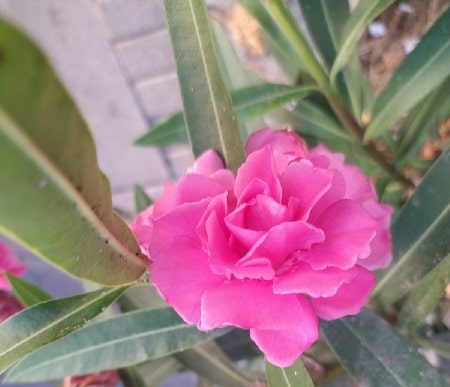The Oleander plant (Nerium oleander) can grow in Hungary. Oleander is a Mediterranean shrub that is known for its beautiful, fragrant flowers and evergreen foliage. It is commonly grown in warm climates and is often found in Mediterranean regions.
Hungary has a temperate climate with four distinct seasons, so the suitability of growing Oleander may depend on the specific location within the country and the prevailing microclimate in that area. In the warmer and sunnier regions of Hungary, such as the southern parts, Oleander can thrive if provided with proper care and protection during colder periods.
It’s worth noting that Oleander is considered toxic, so if you plan to grow it, take appropriate precautions, especially if there are pets or small children around. Always consult with local gardening experts or professionals to determine the best practices for cultivating Oleander in your specific location.
Oleander flower characteristics in Hungary
Oleander (Nerium oleander) is not native to Hungary, and it is not commonly found growing in the wild there. However, it is still possible to cultivate Oleander in Hungary as an ornamental plant, especially in warmer and sunnier regions of the country.

The Oleander flower characteristics are generally consistent regardless of where it is grown. Here are some typical characteristics of Oleander flowers:
- Flower Color: Oleander flowers come in a wide range of colors, including shades of white, pink, red, salmon, and yellow. In Hungary, you can find various cultivated varieties with different flower colors.
- Flower Shape: The flowers are funnel-shaped and have five lobes, giving them a distinctive star-like appearance.
- Fragrance: Oleander flowers are often highly fragrant, emitting a sweet and pleasant scent.
- Blooming Season: Oleander is known for its abundant and prolonged blooming period during the warm months. In Hungary, this typically occurs from late spring to early autumn, with peak flowering in summer.
- Foliage: The plant has leathery, lance-shaped leaves that are evergreen in milder climates. However, in colder regions of Hungary, the leaves may drop during winter.
- Toxicity: It’s essential to note that all parts of the Oleander plant are toxic if ingested, so caution should be taken when planting it, especially in areas where children or pets are present.
Since Hungary has a temperate climate, Oleander may require some protection or special care during colder winter months. Gardeners in Hungary who wish to grow Oleander should consider placing the plant in a warm and sheltered spot, such as against a south-facing wall, to help it withstand potential cold spells.
As always, it’s best to consult with local gardening experts or horticulturists for specific advice on cultivating Oleander in Hungary, considering regional climate variations and any updates in the horticultural practices since my last knowledge update. Oleander properties in Hungary >>
Where is the oleander tree found in Hungary?
As of my last knowledge update in September 2021, Oleander (Nerium oleander) is not a native plant to Hungary, and it is not commonly found growing in the wild there. Since Oleander is a Mediterranean plant that prefers warm and sunny climates, it is more commonly cultivated in regions with a Mediterranean-type climate.
In Hungary, Oleander is mostly grown as an ornamental plant in gardens, parks, and other cultivated areas, especially in the southern parts of the country where the climate is warmer. People in Hungary who wish to have Oleander typically plant it in gardens or containers on patios and balconies, where it can receive enough sunlight and protection from harsh weather.
It’s important to remember that Oleander is a toxic plant, and caution should be taken when planting it, especially in areas where there are children or pets. If you plan to grow Oleander in Hungary, it’s best to consult with local gardening experts or horticulturists for advice on its cultivation and care in the specific location and microclimate where you intend to grow it.

